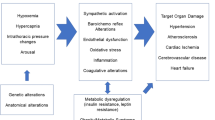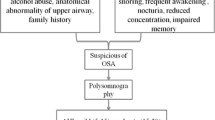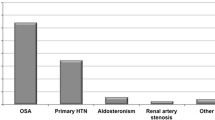Abstract
There is growing evidence of a causal relationship between obstructive sleep apnea (OSA) and hypertension. Untreated OSA may have direct and deleterious effects on cardiovascular function and structure through several mechanisms, including sympathetic activation, oxidative stress, inflammation, and endothelial dysfunction. OSA may contribute to or augment elevated blood pressure levels in a large proportion of the hypertensive patient population. It is important to consider OSA in the differential diagnosis of hypertensive patients who are obese. OSA should be especially considered in those hypertensive patients who respond poorly to combination therapy with antihypertensive medications.
Similar content being viewed by others
References and Recommended Reading
Phillipson EA: Sleep apnea — a major public health problem. N Engl J Med 1993, 328:1271–1273.
Bearpark H, Elliott L, Grunstein R, et al.: Snoring and sleep apnea. A population study in Australian men. Am J Respir Crit Care Med 1995, 151:1459–1465.
Vgontzas AN, Tan TL, Bixler EO, et al.: Sleep apnea and sleep disruption in obese patients. Arch Intern Med 1994, 154:1705–1711.
Strollo PJ, Rogers RM: Obstructive sleep apnea. N Engl J Med 1996, 334:99–104.
Brooks D, Horner RL, Kozar LF, et al.: Obstructive sleep apnea as a cause of systemic hypertension. Evidence from a canine model. J Clin Invest 1997, 99:106–109.
Bixler EO, Vgontzas AN, Lin HM, et al.: Association of hypertension and sleep-disordered breathing. Arch of Intern Med 2000, 160:2289–2295.
Young T, Peppard P, Palta M, et al.: Population-based study of sleep-disordered breathing as a risk factor for hypertension. Arch Intern Med 1997, 157:1746–1752.
Peppard PE, Young T, Palta M, Skatrud J: Prospective study of the association between sleep-disordered breathing and hypertension. N Engl J Med 2000, 342:1378–1784.
Nieto FJ, Young TB, Bonnie KL, et al. for the Sleep Heart Health Study: Association of sleep-disordered breathing, sleep apnea, and hypertension in a large community-based study. JAMA 2000, 283:1829–1836. This study has demonstrated a dose-response association between sleep-disordered breathing at baseline and the presence of de novo hypertension 4 years later. These findings provide strong evidence for a causal relationship between OSA and hypertension.
Haas DC, Foster GL, Nieto FJ, et al.: Age-dependent associations between sleep-disordered breathing and hypertension: importance of discriminating between systolic/ diastolic hypertension and isolated systolic hypertension in the Sleep Heart Health Study. Circulation 2005, 111:614–621. This study has shown that OSA is independently associated with hypertension in the middle-aged subjects but not in the elderly. Thus, the link between sleep-disordered breathing and hypertension may be attenuated by aging.
Baguet JP, Hammer L, Levy P, et al.: Night-time and diastolic hypertension are common and underestimated conditions in newly diagnosed apnoeic patients. J Hypertens 2005, 23:521–527.
Pickering TG, Kario K: Nocturnal non-dipping: what does it augur? Curr Opin Nephrol Hypertens 2001, 10:611–616.
Kraiczi H, Peker Y, Caidahl K, et al.: Blood pressure, cardiac structure and severity of obstructive sleep apnea in a sleep clinic population. J Hypertens 2001, 19:2071–2078.
Drager LF, Bortolotto LA, Lorenzi MC, et al.: Early signs of atherosclerosis in obstructive sleep apnea. Am J Respir Crit Care 172:613–618.
Sampol G, Romero O, Salas A, et al.: Obstructive sleep apnea and thoracic aorta dissection. Am J Respir Crit Care Med 2003, 168:1528–1531.
Wolk R, Shamsuzzaman AS, Somers VK: Obesity, sleep apnea, and hypertension. Hypertension 2003, 42:1067–1074.
Somers VK, Dyken ME, Mark AL, Abboud FM: Sympathetic nerve activity during sleep in normal humans. N Engl J Med 1993, 328:303–307.
Somers VK, Dyken ME, Clary MP, Abboud FM: Sympathetic neural mechanisms in obstructive sleep apnea. J Clin Invest 1995, 96:1897–1904.
Carlson JT, Hedner J, Elam M, et al.: Augmented resting sympathetic activity in awake patients with obstructive sleep apnea. Chest 1993, 103:1763–1768.
Narkiewicz K, van de Borne PJH, Cooley RL, et al.: Sympathetic activity in obese subjects with and without obstructive sleep apnea. Circulation 1998, 98:772–776.
Narkiewicz K, Montano N, Cogliati C, et al.: Altered cardiovascular variability in obstructive sleep apnea. Circulation 1998, 98:1071–1077.
Narkiewicz K, van de Borne PJH, Montano N, et al.: The contribution of tonic chemoreflex activation to sympathetic activity and blood pressure in patients with obstructive sleep apnea. Circulation 1998, 97:943–945.
Parati G, Di Rienzo M, Bonsignore MR, et al.: Autonomic cardiac regulation in obstructive sleep apnea syndrome: evidence from spontaneous baroreflex analysis during sleep. J Hypertens 1997, 15:1621–1626.
Narkiewicz K, Pesek CA, Kato M, et al.: Baroreflex control of sympathetic activity and heart rate in obstructive sleep apnea. Hypertension 1998, 32:1039–1043.
Singh JP, Larson MG, Tsuji H, et al.: Reduced heart rate variability and new-onset hypertension: insights into pathogenesis of hypertension: the Framingham Heart Study. Hypertension 1998, 32:293–297.
Parati G, Di Rienzo M, Ulian L, et al.: Clinical relevance blood pressure variability. J Hypertens 1998, 16:S25-S33.
Moller DS, Lind P, Strunge B, Pedersen EB: Abnormal vasoactive hormones and 24-hour blood pressure in obstructive sleep apnea. Am J Hypertens 2003, 16:274–280.
Calhoun DA, Nishizaka MK, Zaman MA, Harding SM: Aldosterone excretion among subjects with resistant hypertension and symptoms of sleep apnea. Chest 2004, 125:112–117.
Ip MS, Lam B, Ng MM, et al. Obstructive sleep apnea is independently associated with insulin resistance. Am J Respir Crit Care Med 2002, 165:670–676.
Punjabi NM, Sorkin JD, Katzel LI, et al.: Sleep-disordered breathing and insulin resistance in middle-aged and overweight men. Am J Respir Crit Care Med 2002, 165:677–682.
Phillips BG, Kato M, Narkiewicz K, et al.: Increases in leptin levels, sympathetic drive, and weight gain in obstructive sleep apnea. Am J Physiol 2000, 279:H234-H237.
Shamsuzzaman AS, Winnicki M, Lanfranchi P, et al.: Elevated C-reactive protein in patients with obstructive sleep apnea. Circulation 2002, 105:2462–2464.
Schulz R, Mahmoudi S, Hattar K, et al.: Enhanced release of superoxide from polymorphonuclear neutrophils in obstructive sleep apnea: impact of continuous positive airway pressure therapy. Am J Respir Crit Care Med 2000, 162:566–570.
Yamauchi M, Nakano H, Maekawa J, et al.: Oxidative stress in obstructive sleep apnea. Chest 2005, 127:1674–1679.
Phillips BG, Narkiewicz K, Pesek CA, et al.: Effects of obstructive sleep apnea on endothelin-1 and blood pressure. J Hypertens 1999, 17:61–66.
Kato M, Roberts-Thomson P, Phillips BG, et al.: Impairment of endothelium-dependent vasodilation of resistance vessels in patients with obstructive sleep apnea. Circulation 2000, 102:2607–2610.
Allahdadi KJ, Walker BR, Kanagy NL: Augmented endothelin vasoconstriction in intermittent hypoxia-induced hypertension. Hypertension 2005, 45:705–709.
Jean-Louis G, Zizi F, Casimir G, et al.: Sleep-disordered breathing and hypertension among African Americans. J Hum Hypertens 2005, 19:485–490.
Lin L, Finn L, Zhang J, et al.: Angiotensin-converting enzyme, sleep-disordered breathing, and hypertension. Am J Respir Crit Care Med 2004, 170:1349–1353.
Wilcox I, Grunstein RR, Hedner JA, et al.: Effect of nasal continuous positive airway pressure during sleep on 24-hour blood pressure in obstructive sleep apnea. Sleep 1993, 16:539–544.
Faccenda JF, Mackay TW, Boon NA, Douglas NJ: Randomized placebo-controlled trial of continous positive airway pressure on blood pressure in the sleep apnea-hypopnea syndrome. Am J Respir Crit Care Med 2001, 163:344–348.
Pepperell JC, Ramdassingh-Dow S, Crosthwaite N, et al.: Ambulatory blood pressure after therapeutic and subtherapeutic nasal continuous positive airway pressure for obstructive sleep apnoea: a randomised parallel trial. Lancet 2002, 359:204–210.
Sanner BM, Tepel M, Markmann A, Zidek W: Effect of continuous positive airway pressure therapy on 24-hour blood pressure in patients with obstructive sleep apnea syndrome. Am J Hypertens 2002, 15:251–257.
Becker HF, Jerrentrup A, Ploch T, et al.: Effect of nasal continuous positive airway pressure treatment on blood pressure in patients with obstructive sleep apnea. Circulation 2003, 107:68–73. This controlled study has demonstrated that effective CPAP treatment leads to a substantial blood pressure reduction in OSA patients. Subtherapeutic CPAP, despite a 50% reduction in the AHI, did not decrease blood pressure.
Narkiewicz K, Kato M, Phillips BG, et al.: Nocturnal continuous positive airway pressure decreases daytime sympathetic traffic in obstructive sleep apnea. Circulation 1999, 100:2332–2335. Long-term CPAP treatment decreases sympathetic traffic in otherwise healthy OSA patients. Thus, CPAP may provide beneficial effects beyond better blood pressure control.
Babu AR, Herdegen J, Fogelfeld L, et al.: Type 2 diabetes, glycemic control, and continuous positive airway pressure in obstructive sleep apnea. Arch Intern Med 2005, 165:447–452. Using a 72-hour continuous glucose monitoring system, the authors have demonstrated that CPAP treatment improves glycemic control in type 2 diabetics.
Harsch IA, Schahin SP, Radespiel-Troger M, et al.: Continuous positive airway pressure treatment rapidly improves insulin sensitivity in patients with obstructive sleep apnea syndrome. Am J Respir Crit Care Med 2004, 169:156–162.
Buchwald H, Avidor Y, Braunwald E, et al.: Bariatric surgery. A systematic review and meta analysis. JAMA 2004, 292:1724–1737. A systematic review and meta-analysis of articles on bariatric surgery showing that up to 85% of OSA patients experience complete resolution of sleep-disordered breathing.
Logan AG, Perlikowski SM, Mente A, et al.: High prevalence of unrecognized sleep apnoea in drug-resistant hypertension. J Hypertens 2001, 19:2271–2277.
Portaluppi F, Provini F, Cortelli P, et al.: Undiagnosed sleepdisordered breathing among male nondippers with essential hypertension. J Hypertens 1997, 15:1227–1233.
Author information
Authors and Affiliations
Rights and permissions
About this article
Cite this article
Narkiewicz, K., Wolf, J., Lopez-Jimenez, F. et al. Obstructive sleep apnea and hypertension. Curr Cardiol Rep 7, 435–440 (2005). https://doi.org/10.1007/s11886-005-0061-z
Issue Date:
DOI: https://doi.org/10.1007/s11886-005-0061-z




